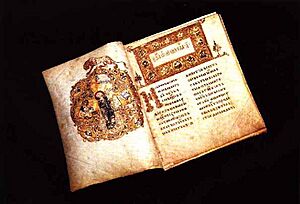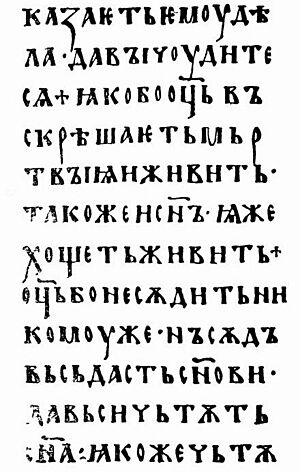Ostromir Gospels facts for kids

The Ostromir Gospels (Russian: Остромирово Евангелие) is the oldest book from Kievan Rus that has a clear date written in it. It was made a very long time ago, in 1056 or 1057. This special book is kept safe today at the National Library of Russia.
Even though another old text, the Novgorod Codex, was found and is even older, it doesn't have a specific date written on it. That's why the Ostromir Gospels is known as the oldest dated book. It was created by a deacon named Gregory for his boss, Ostromir, who was a leader in Novgorod. It was probably a gift for a monastery.
What is the Ostromir Gospels?
This book is a special kind of illuminated manuscript. That means it's a handwritten book with beautiful pictures and decorations. It's also a Gospel Book lectionary, which means it contains parts of the Gospels meant to be read on Sundays and special holidays.
The book is very large, about 20 by 24 centimeters. It has 294 pages made of parchment (treated animal skin). The writing is in a big, clear style called uncial, with eighteen lines on each page. At the very end of the book, the scribe (the person who wrote it) added a note explaining when and how the book was made.
Art and Illustrations
The Ostromir Gospels has three amazing full-page pictures of the evangelist portraits (the writers of the Gospels). Two different artists created these pictures. Many other pages also have beautiful designs and decorations.
These pictures look a lot like those in another old book called the Mstislav Lectionary. This suggests that both books might have been copied from an even older, now lost, original book. The artists who drew the evangelist portraits were inspired by art from the Byzantine Empire. The pictures of Saints Mark and Luke seem to be influenced by Byzantine enamel art, not just other books.
Many old Russian books have survived from Novgorod. This is because Novgorod was never taken over by the Mongols, unlike other cities. Like other old Russian books, the Ostromir Gospels is written in a special local version of Church Slavonic. For example, it uses slightly different spellings for words like "water" and "friend" compared to the standard Old Slavonic.
Journey Through Time
People believe this important book was moved from a monastery in Novgorod to the private collection of the Russian tsars in the Moscow Kremlin. It was first officially recorded there in 1701.
Later, Peter the Great ordered the book to be moved to St. Petersburg. It wasn't mentioned again until 1805, when it was found in the dressing room of the late Catherine the Great.
The Gospels were then placed in the Imperial Public Library in St Petersburg, where they still are today. A scholar named Alexander Vostokov was the first to study it very closely. He showed that the language in the book reflected the way people spoke in Old East Slavic areas. The first copy of the book was printed under his guidance in 1843.
In 1932, something surprising happened. A plumber broke into the case where the book was kept because its cover was decorated with valuable gems. He stole the binding but hid the parchment pages behind a bookcase. Luckily, the book was found quickly, but it still doesn't have a new binding today.
See also
- Codex Zographensis (late 10th century or early 11th century)
- Novgorod Codex (first quarter of the 11th century)
- Svyatoslav's Miscellanies (1073, 1076)
- Archangel Gospel (1092)
- Mariinsky Gospel (11th century)
- Mstislav Gospel (1117)
- Yuriev Gospel (1119)
- Halych Gospel (1144)
- Dobrila Gospel (1164)
- Pantaleon Gospel (12th century)
- Eusebius Gospel (1282)
- Chelm Gospel (13th century)


